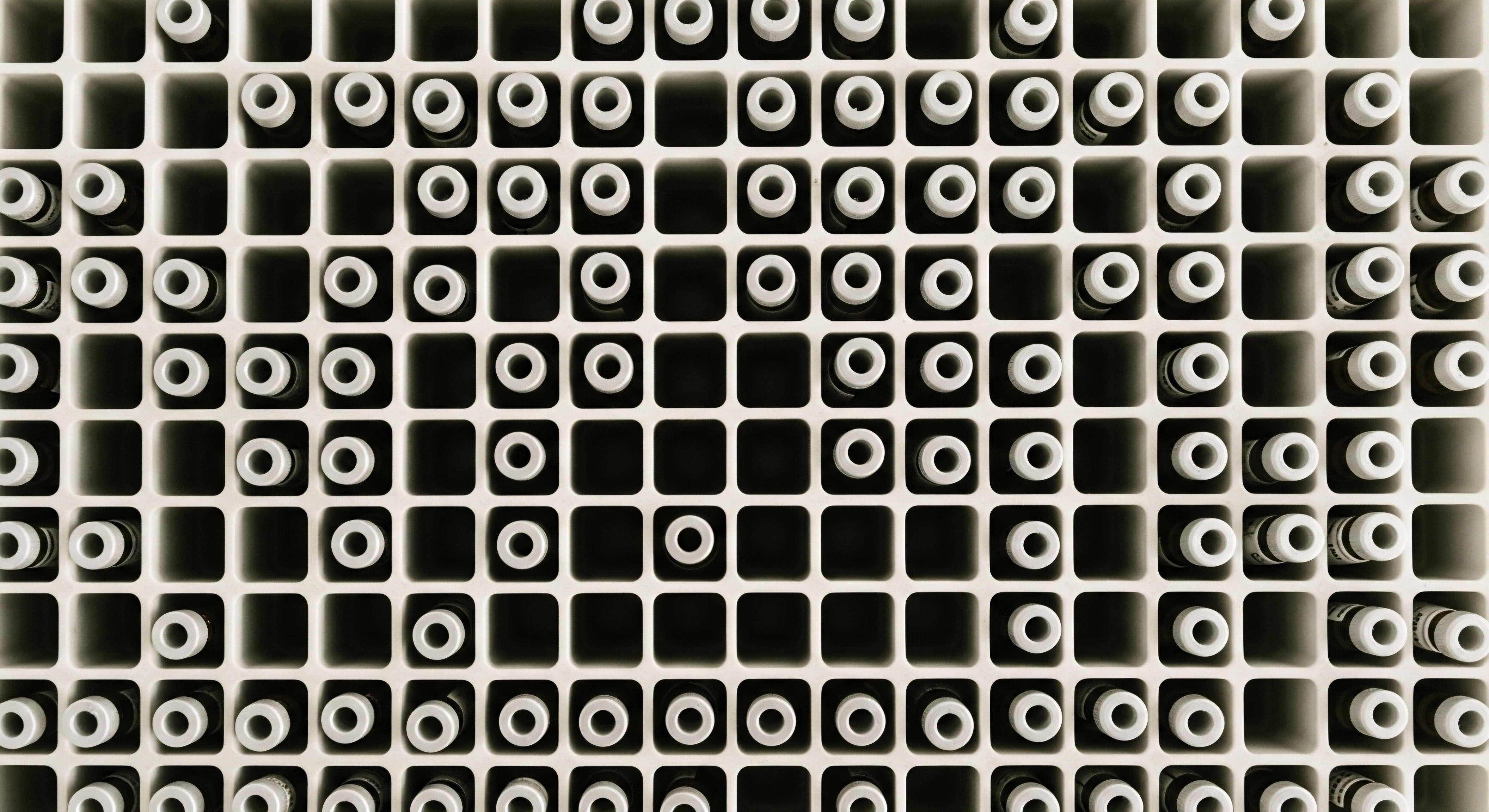

Fundamentals
You hold in your hand a small glass vial, cool to the touch. Inside is a clear liquid, a substance prescribed to you with the promise of recalibrating a system within your body that has drifted from its optimal state.
This could be Testosterone Cypionate to restore your body’s hormonal baseline, or a peptide like Sermorelin or Ipamorelin, designed to encourage your own pituitary gland to function as it did in your youth. The feeling is one of potential, a clinical tool to help you reclaim your energy, your focus, and your sense of well-being.
Accompanying this potential is a set of very specific instructions, with one standing out in its urgency ∞ maintain the correct temperature. This instruction is the anchor point for the entire therapeutic process. The journey to understanding your own biological restoration begins with appreciating the profound fragility of these powerful molecules.
These molecules, peptides and hormones, are messengers. They are exquisitely shaped keys designed by science to fit specific biological locks, or receptors, on the surface of your cells. When a peptide key like Ipamorelin turns its specific lock in the pituitary gland, it sends a precise signal ∞ “release growth hormone.” When testosterone interacts with its receptors, it communicates a cascade of instructions related to muscle maintenance, bone density, and metabolic function.
The effectiveness of this entire system of communication hinges on the structural integrity of the key. Its shape must be perfect. Any deviation, any bending or warping of its structure, renders it unable to fit the lock. When this happens, the message is never delivered. The potential in the vial remains just that, unrealized potential.
The structural integrity of a therapeutic peptide is the foundation of its biological efficacy.

The Concept of Molecular Fragility
Peptides are chains of amino acids, linked together in a precise sequence and then folded into a unique three-dimensional shape. This final, folded structure is what gives the peptide its function. This architecture, however, is delicate. It is held together by a series of relatively weak chemical bonds that are highly susceptible to environmental conditions, especially temperature.
Exposure to excessive heat provides energy that causes the molecule to vibrate violently, breaking these weak bonds and causing the structure to unravel, a process called denaturation. Imagine a meticulously crafted key melting; its fine-tooled edges and grooves become a formless piece of metal, unable to open any lock. The peptide has become biologically inert.
Conversely, freezing presents a different but equally damaging threat. As water in the solution crystallizes, it forms sharp, jagged ice structures that can physically shear the peptide chains. Furthermore, the process of freezing concentrates the peptide molecules into smaller and smaller pockets of unfrozen liquid, which can cause them to clump together, or aggregate.
These aggregated clumps are inactive and can sometimes even trigger an unwanted immune response. The key has not melted, but it has been shattered into useless fragments or fused into an unrecognizable mass. This is why the instructions often specify refrigeration, a carefully controlled cool environment that slows molecular motion without causing the destructive formation of ice crystals.

Protecting Your Investment in Health
The clinical strategies to mitigate these effects begin long before the vial reaches your hands. The entire supply chain, from the compounding pharmacy to your doorstep, is governed by a principle known as the “cold chain.” This is a continuous, temperature-controlled logistics network of refrigerated transport and storage designed to protect the peptide’s integrity.
When you receive your package with its cold packs, you are witnessing the final link in that chain. Your role is to become the custodian of that integrity.
Adhering to the storage protocols is your primary strategy for ensuring the peptide you administer is the peptide the pharmacy prepared. This means promptly refrigerating the vial and protecting it from temperature extremes.
If you are reconstituting a lyophilized (freeze-dried) powder, the sterile water you use should be at room temperature to avoid shocking the delicate molecules, and the mixing process should be a gentle swirl, never a vigorous shake.
Each step is a measure to preserve the peptide’s structure, ensuring that when you perform your injection, you are delivering the precise, intact message your body is waiting to receive. This diligence protects your financial investment and, more importantly, it protects the therapeutic opportunity to guide your body back to a state of optimal function.


Intermediate
To truly appreciate the clinical imperative of temperature control, we must look deeper, into the dynamic life of a peptide molecule within the body. The moment a therapeutic peptide like Testosterone Cypionate or CJC-1295/Ipamorelin is administered, its journey is governed by two core pharmacological principles ∞ pharmacokinetics (PK) and pharmacodynamics (PD).
Pharmacokinetics describes what the body does to the drug ∞ its absorption, distribution, metabolism, and excretion. It dictates how long the peptide remains active in your system. Pharmacodynamics describes what the drug does to thebody ∞ its interaction with cellular receptors and the resulting biological response. A temperature excursion is a direct assault on the foundational integrity of the molecule, which in turn disrupts its predictable PK/PD profile and undermines the entire therapeutic goal.
A properly stored peptide has a known half-life and a predictable effect. For instance, the combination of CJC-1295 and Ipamorelin is designed to create a specific, synergistic pulse of growth hormone release. The efficacy of this protocol depends on both molecules being fully active at the time of injection.
If a temperature excursion has denatured even a portion of the peptides, the dose you administer is effectively lower than prescribed. The resulting growth hormone pulse will be blunted, and the downstream benefits ∞ improved sleep, enhanced recovery, better metabolic function ∞ will be compromised. You are following the protocol, yet the biological signal is weak and inconsistent.
This is a primary reason why clinicians stress the importance of the cold chain; it is the only way to guarantee that the prescribed dose is the biologically active dose.

How Do Formulation Scientists Design Peptides for Enhanced Stability?
Recognizing the inherent fragility of peptides, chemists and formulation scientists have developed ingenious strategies to build more robust molecules. These modifications are designed to protect the peptide from both enzymatic degradation in the body and environmental stressors like temperature. These are proactive clinical strategies implemented at the molecular level.

Structural Fortification Techniques
The architecture of the peptide itself can be modified to create a more resilient structure. These are subtle but powerful changes that enhance stability without altering the core message the peptide delivers.
- D-Amino Acid Substitution Your body’s enzymes are designed to recognize and break down proteins made of L-amino acids, the natural form. By strategically replacing a key L-amino acid with its mirror-image counterpart, a D-amino acid, scientists create a point in the peptide chain that is resistant to enzymatic cleavage. This is like replacing a standard screw with a proprietary one that the body’s standard tools cannot dismantle, significantly extending the peptide’s active life.
- Peptide Cyclization Many peptides exist as linear chains, leaving their ends (the N-terminus and C-terminus) vulnerable to attack by enzymes. Cyclization connects these two ends, forming a closed loop. This structural reinforcement makes the peptide more rigid and stable, protecting it from both enzymatic breakdown and thermal denaturation. Pasireotide, a synthetic somatostatin analogue, utilizes this strategy to achieve an exceptionally long half-life of nearly 12 hours.
- Terminal Group Protection A related strategy involves “capping” the vulnerable ends of a linear peptide. The N-terminus can be protected by a process called acetylation, and the C-terminus can be protected by amidation. These molecular caps act as shields, blocking the enzymes that would normally begin dismantling the peptide from its ends, thereby preserving its integrity and extending its bioavailability.
Molecular modifications and advanced formulation science are key proactive strategies to protect peptide efficacy against degradation.

The Protective Science of Formulation
Beyond modifying the peptide itself, the solution it is suspended in provides another layer of critical protection. This is where formulation science becomes paramount. The clear liquid in the vial is a carefully engineered micro-environment.
Excipients are inactive ingredients added to the formulation that fulfill specific protective roles. Buffering agents maintain a stable pH, as shifts in acidity can also cause peptides to denature. Cryoprotectants are used during the lyophilization (freeze-drying) process to protect the peptide from the stresses of freezing, while lyoprotectants provide stability to the final dried powder.
When you reconstitute a lyophilized peptide, you are reintroducing it into a liquid environment, and the quality of that reconstitution is critical. Using the correct bacteriostatic water and employing gentle mixing techniques ensures the peptide dissolves correctly without being damaged.
The table below outlines handling protocols for common therapeutic peptides, underscoring the practical application of these principles.
| Peptide Protocol | Storage Condition (Unreconstituted) | Storage Condition (Reconstituted) | Common Temperature Sensitivity |
|---|---|---|---|
| Testosterone Cypionate | Controlled Room Temperature (20°C to 25°C) | N/A (Oil-based) | Sensitive to extreme heat and cold; crystal formation can occur if refrigerated. |
| Sermorelin / Ipamorelin (Lyophilized) | Refrigerated (2°C to 8°C) | Refrigerated (2°C to 8°C) | Highly sensitive to heat once reconstituted. Avoid freezing. |
| CJC-1295 (Lyophilized) | Refrigerated (2°C to 8°C) | Refrigerated (2°C to 8°C) | Very fragile; sensitive to heat and agitation after reconstitution. |
| PT-141 (Lyophilized) | Refrigerated (2°C to 8°C) | Refrigerated (2°C to 8°C) | Loses potency rapidly at room temperature once reconstituted. |
This table illustrates a fundamental point. While all peptides require careful handling, their specific formulations dictate the precise protocols. An oil-based hormone like Testosterone Cypionate has different storage requirements than a water-soluble lyophilized peptide like Sermorelin. Understanding and adhering to the specific instructions for your therapy is the most direct clinical strategy you can employ to ensure its success.


Academic
A comprehensive analysis of peptide stability transcends simple temperature management and enters the domain of advanced pharmaceutical science and systems biology. The clinical challenge is to ensure that a precisely engineered molecule not only survives storage and transport but also navigates the hostile environment of the human body to arrive at its target receptor in its active conformation.
The strategies to achieve this involve a multi-layered approach, encompassing advanced molecular design, sophisticated drug delivery systems, and rigorous analytical validation to quantify and predict stability.
At the molecular level, peptide degradation is a complex process involving several distinct chemical pathways. A temperature excursion can initiate or accelerate these reactions. Oxidation can occur at specific amino acid residues like methionine or tryptophan. Deamidation, the removal of an amide group from asparagine or glutamine residues, can introduce a negative charge that alters the peptide’s structure and function.
Aggregation, where individual peptide molecules clump together into non-functional and potentially immunogenic masses, is a common consequence of both thermal stress and freezing. Each of these degradation pathways results in a loss of efficacy, transforming a potent therapeutic agent into an inert or even harmful substance. The core clinical strategy, therefore, is one of proactive prevention through sophisticated formulation and delivery technologies.

What Are the Commercial Implications of Cold Chain Failures in Peptide Distribution?
The commercial and clinical consequences of a breach in the cold chain are substantial. For pharmaceutical manufacturers and compounding pharmacies, a single failure can invalidate an entire batch of product, resulting in significant financial loss and supply chain disruptions. For the patient and clinician, the implications are even more serious.
Administering a degraded peptide can lead to complete therapeutic failure, causing the patient to lose faith in the treatment and the clinician to question the diagnosis or protocol. This underscores the immense investment in developing stabilization technologies that can create more robust products, capable of withstanding minor, transient temperature excursions that can occur outside the controlled environment of the pharmacy.

Controlled-Release Drug Delivery Systems
One of the most advanced strategies for mitigating the effects of both environmental exposure and rapid in-vivo degradation is the use of controlled-release delivery systems. These systems encapsulate peptides within a protective matrix, shielding them from the external environment and then releasing them over an extended period within the body.
Biodegradable polymers, such as poly(lactic-co-glycolic acid) (PLGA), are often used to create microspheres that contain the peptide. The peptide is protected within this solid matrix until the microsphere is injected. Once in the body, the polymer slowly degrades through hydrolysis, releasing the active peptide in a controlled, predictable manner.
This technology provides a physical barrier against temperature fluctuations and also reduces the need for frequent injections, improving patient adherence. It fundamentally changes the stability challenge from protecting a liquid solution to preserving a much more stable solid-state formulation.

Advanced Stabilization and Conjugation Technologies
Beyond encapsulation, other advanced techniques aim to enhance peptide stability by altering the molecule’s interaction with its environment. These methods represent the cutting edge of peptide pharmacology.
- Lyophilization (Freeze-Drying) ∞ This process involves freezing the peptide solution and then removing the water through sublimation under a vacuum. This transitions the peptide into a stable, powdered state that is far less susceptible to temperature-related degradation. The process itself is complex, requiring the use of cryoprotectants to prevent damage during freezing and lyoprotectants to ensure the stability of the final cake. A properly lyophilized peptide can be stable for years at refrigerated temperatures, whereas its reconstituted liquid form may only be stable for weeks.
- Albumin Binding ∞ This innovative strategy involves conjugating the peptide to a molecule that has a high affinity for albumin, a major protein in human blood. Once injected, the peptide “hitches a ride” on the much larger albumin molecule. This albumin-bound state serves two purposes ∞ it shields the peptide from enzymatic degradation and it prevents it from being rapidly cleared by the kidneys, dramatically extending its half-life. The long-acting growth hormone derivative somapacitan utilizes this technology to allow for once-weekly dosing instead of daily injections.

How Can We Quantify the Efficacy Loss after a Thermal Event?
When a temperature excursion is suspected, it is clinically vital to have methods to assess the remaining potency of the peptide. Visual inspection is the first step; cloudiness, discoloration, or particulate matter are clear signs of degradation. However, many forms of degradation are invisible. This is where advanced analytical techniques become essential.
| Analytical Method | Principle of Operation | Information Provided |
|---|---|---|
| High-Performance Liquid Chromatography (HPLC) | Separates components of a mixture based on their chemical properties as they are passed through a column under high pressure. | Quantifies the purity of the peptide and detects the presence of degradation products or aggregates. A “clean” peak indicates high purity. |
| Mass Spectrometry (MS) | Measures the mass-to-charge ratio of ionized molecules, allowing for precise determination of molecular weight. | Confirms the identity and structural integrity of the peptide. Can detect modifications like oxidation or deamidation that alter the molecular mass. |
| Circular Dichroism (CD) Spectroscopy | Measures the differential absorption of left- and right-circularly polarized light to analyze the peptide’s secondary structure (e.g. alpha-helices, beta-sheets). | Provides direct information about the peptide’s three-dimensional folding. A change in the CD spectrum indicates denaturation. |
| In-Vitro Bioassay | Exposes cultured cells with the target receptor to the peptide and measures the resulting biological response (e.g. hormone secretion). | Directly assesses the functional potency of the peptide. Answers the question ∞ “Can the peptide still activate its target?” |
Advanced analytical methods provide the definitive assessment of a peptide’s structural and functional integrity following a potential temperature excursion.
These academic-level strategies, from molecular fortification and advanced delivery systems to rigorous analytical validation, form the backbone of modern peptide therapy. They represent a concerted clinical and scientific effort to ensure that these powerful but fragile molecules can deliver their intended biological message with precision and reliability.
The goal is to build a system of interlocking safeguards that protects the peptide’s efficacy from the moment of its synthesis to the moment it binds to its cellular receptor, mitigating the risks at every step of its journey.

References
- Shishir, Mohammad Rezaul Islam, et al. “Strategies for overcoming protein and peptide instability in biodegradable drug delivery systems.” Pharmaceutics, vol. 14, no. 1, 2022, p. 194.
- Lau, J. L. & Dunn, M. K. “Therapeutic peptides ∞ Historical perspectives, current development trends, and future directions.” Bioorganic & Medicinal Chemistry, vol. 26, no. 10, 2018, pp. 2700-2707.
- de Jong, Tessa, et al. “Strategies Towards Improving Clinical Outcomes of Peptide Receptor Radionuclide Therapy.” Current Oncology Reports, vol. 23, no. 5, 2021, p. 55.
- Yuen, Kevin C. J. et al. “Developments in the Management of Growth Hormone Deficiency ∞ Clinical Utility of Somapacitan.” Drug Design, Development and Therapy, vol. 18, 2024, pp. 329-345.
- A.S. Lund, et al. “Tissue distribution and receptor activation by somapacitan, a long acting growth hormone derivative.” International Journal of Molecular Sciences, vol. 21, no. 4, 2020, p. 1181.

Reflection

From Molecule to Self
We have explored the intricate world of peptide stability, from the fundamental fragility of a molecule to the advanced science used to protect it. You now understand that the cool vial in your refrigerator holds more than a liquid; it contains a precise biological message, preserved through a chain of careful actions.
You are the final and most important guardian of that message. This knowledge itself is a clinical tool. It transforms the act of storage and administration from a chore into a conscious act of participation in your own health protocol.
This understanding of the molecule’s journey is a powerful starting point. The next step in this process is to turn that same focused attention inward. How does your own unique biological system receive these messages? How do your sleep, your nutrition, and your stress levels influence the environment into which these signals are sent?
The science of personalized wellness is a dialogue between precise clinical tools and the complex, dynamic system of your own body. Appreciating the care required to preserve the integrity of a therapeutic peptide prepares you to apply that same level of care to the choices that shape your health every day.
The ultimate goal is to create a state of internal coherence where these external signals can be received with maximum effect, allowing you to fully realize the potential for vitality that you seek.

Glossary

testosterone cypionate

ipamorelin

growth hormone

cold chain

pharmacokinetics

temperature excursion

d-amino acid substitution

peptide cyclization

lyophilization

sermorelin

drug delivery systems




